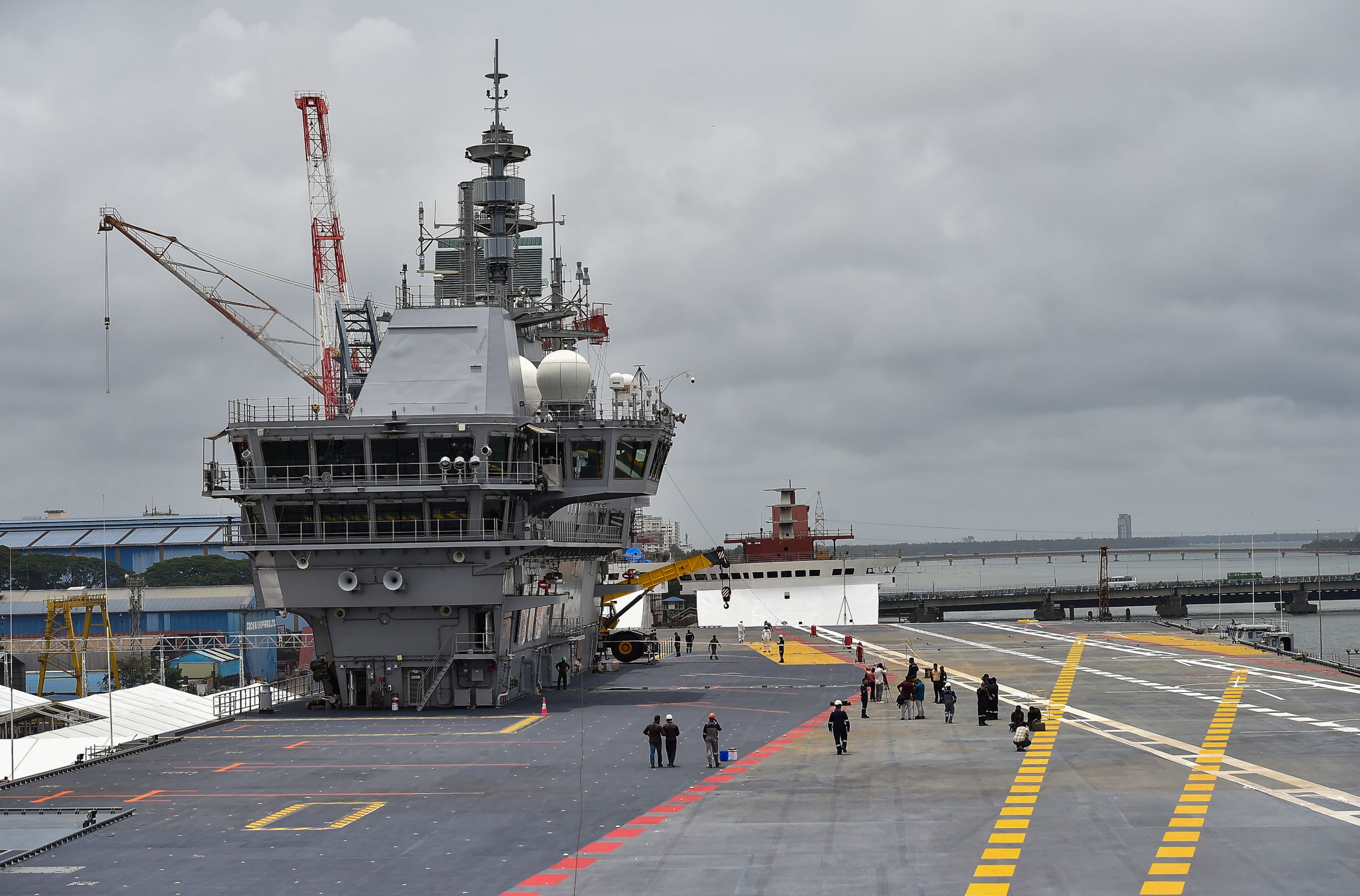The launching of India’s first indigenous aircraft carrier (IAC-1) as INS Vikrant marks a pivotal event in the country’s naval history. Prime Minister Narendra Modi introduced the new Naval Ensign ‘Nishaan’ at Cochin Shipyard Limited in Kochi during the commissioning of the indigenous aircraft carrier INS Vikrant on Friday.
Also Read| INS Vikrant: 10 Features of India’s first homemade aircraft carrier
India joins an elite group of nations – United States, Russia, France, United Kingdom, and China – capable of designing and building aircraft carriers. INS Vikrant is also projected to be the seventh largest carrier or carrier class in the world, having a displacement of 43,000 tonnes when fully loaded.
Recently, China also unveiled its third aircraft carrier in June of this year, the country’s most advanced and wholly domestically manufactured military vessel, as Beijing aimed to expand its navy’s range in the Indo-Pacific area. The Shanghai shipyard had a brief ceremony to launch the aircraft carrier with the name Fujian, according to reports from the eastern metropolis.
With the addition of the INS Vikrant, India now possesses two aircraft carriers, as opposed to China’s three.
Also Read| INS Vikrant: Cost, length, where it is docked all you need to know
India’s aircraft carriers:
INS Vikramaditya
The Indian Navy received a modified Kiev-class aircraft carrier on November 16, 2013. Long-time military allies India and Russia reached a crucial naval agreement in 2004 to incorporate the aircraft carrier into the Indian Navy. With a displacement of 45,000 tonnes, the aircraft carrier can carry more than 30 planes and helicopters. The carrier, which has a total of 22 decks, can house more than 1,600 individuals on board, including commanders and sailors. The INS Vikramaditya is also the first warship to feature an ATM. The yacht holds a State Bank of India ATM that operates through a satellite connection.
INS Vikramaditya was apparently involved in an accident in June 2016 while undergoing a planned major refit at Karwar naval base. A sailor and a civilian worker died after a hazardous gas leak occurred during maintenance work in the warship’s Sewage Treatment Plant compartment.
Also Read| Indian Army putting swarm drones in mechanized forces: All you need to know
INS Vikrant
The INS Vikrant is 262 metres long and 62 metres broad. When fully loaded, the aircraft carrier displaces approximately 4,3000 tonnes, has a maximum planned speed of 28 knots, and a range of 7,500 nautical miles, or approximately 14,000 kilometres.
The 18-story-high ship has about 2,400 compartments and is planned to seat a 1,600-person crew. The aviation hangar can house up to 20 aircraft and has a well-equipped kitchen.
Its medical complex includes a 16-bed hospital, physiotherapy clinic, Intensive Care Unit, pathology setup, radiology wing with a CT scanner and X-Ray machines, dentistry complex, isolation ward, and telemedicine amenities.
When fully operational, the carrier will feature an air wing of 30 aircraft, including Russian-origin, carrier-capable MiG-29K fighter jets and airborne early warning control helicopter Kamov-31 helicopters, US-origin MH-60R multi-role helicopters, and domestic Advanced Light Helicopters (ALH) and Light Combat Aircraft (LCA) (Navy). Vikrant has the Short Take Off but Arrested Recovery (STOBAR) concept, which includes a ski-jump for launching aircraft and three arrester wires for onboard recovery.
Vikrant was built at a cost of around Rs 20,000 crore. The Navy has said that between 80 and 85% of the funds have been reinvested in the Indian economy, with full indigenous construction, 76% indigenous content, and 2,000 CSL workers engaged, with another 13,000 indirectly employed.
Also Read| Who was Axel, Indian Army dog killed in anti-militant operation in Kashmir?
China’s aircraft carriers:
Liaoning
The Liaoning, China’s first aircraft carrier, was launched in 2012. This warship was a refit of an unfinished Soviet Kuznetsov-class cruiser carrier. The aircraft carrier was outfitted with locally designed equipment such as the Type 381 3D active electronically scanned array radar. The Chinese H/PJ-14 gun and FL-3000N missile systems also offered point defence. The carrier’s primary strike force consists of J-15 combat aircraft. This system was built on J-11, the Chinese reverse engineering version of the Su-27. Furthermore, Liaoning is equipped with Z-18F anti-submarine warfare, Z-18J airborne early warning, and Z-9C rescue helicopters, according to the navalpost.
The ship has a total load displacement of 67,500 tonnes, a length of 304.5 metres, a beam of 75 metres, and drafts of 8.97 metres. The Liaoning’s top speed is 32 knots, and at that pace, she can go 7,130 kilometres without refuelling.
Also Read| US naval officer jailed in Japan, family seeks Biden’s intervention
Shandong
Shandong, China’s first indigenously built aircraft carrier, was launched on April 26, 2017. The size of Liaoning and Shandong is comparable, and both employ a STOBAR (Short Take-Off But Arrested Recovery) technology to launch and recover aircraft. Shandong, which was built in recent years, has far more modern technology and notable equipment than Liaoning. The Shandong is 305 metres long, 75 metres wide, and has a total load displacement of 70,000 tonnes. It can carry up to 44 aircraft on its deck.
Fujian
In June 2022, the country’s most advanced and first entirely domestically manufactured navy warship was presented. China State Shipbuilding Corporation Limited’s third aircraft carrier has a displacement of more than 80,000 tonnes and is outfitted with electromagnetic catapults and arresting systems. The Type 003 battleship, hull number 18, is China’s first carrier to employ an electromagnetic catapult to launch planes from the deck, which is faster than the traditional steam catapult technology. The Fujian has a flat-top flight deck, unlike China’s other two aircraft carriers, which have ski-jump take-off ramps.







